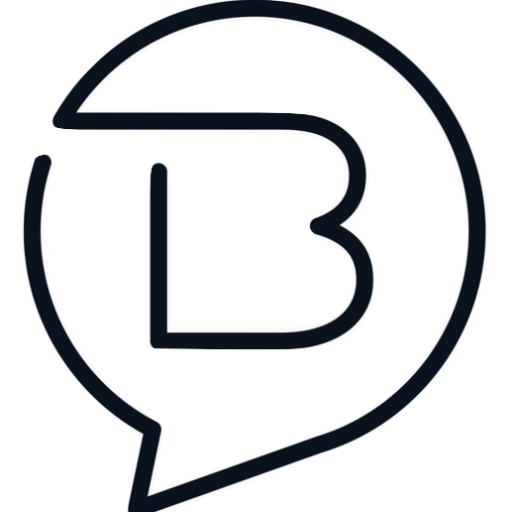Introduction
My writing and teaching experience provided me with the opportunity to work with a number of AI-generated writing detection tools. I have discussed in detail both the similarity and dissimilarity of the two most used platforms: ZeroGPT and Copyleaks.AI in this comprehensive blog post. In this digital age, humans-created and machine-generated contents are hard to distinguish from each other. This is becoming more and more significant because AI detection tools are now becoming increasingly important in different sectors.
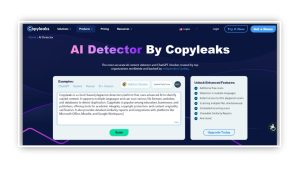
The Rise of AI-Generated Content
Before jumping into the comparison, it is important to have an overview. The indoctrination of large language models like GPT-3 and GPT-4 has indeed set a turning point in content creation. These AI algorithms produce realistic human text in a variety of areas, which is why the authenticity and origin of the writing are among the predominant questions raised.
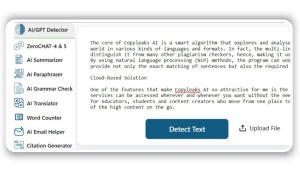
It’s functions in more than one area:
Education:
Learners might be inclined to avail themselves of AI assistance in writing essays or preparing reports which is the guiding concern for teachers.
Journalism:
The development of AI-generated news articles raises questions of ethics on the horizon.
Marketing:
Even companies are switch to AI for huge volumes of content.
Literature:
The possibility of AI to generate books threatened the market.
Due to these concerns, tools like ZeroGPT and Copyleaks.AI have emerged to help verify or validate contents that were generated with the assistance of AI, thus establishing originality and human creativity.
ZeroGPT: A Simple Approach to AI Detection
ZeroGPT is a very convenient tool for classroom and dissertation writing, which I have found to be quite effective. Its good looking and rapid returns make it frequently chosen by both educators and students.
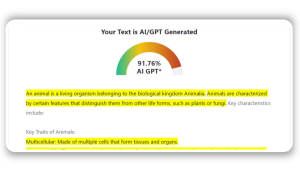
Key Features of ZeroGPT
Free to use:
This makes it possible for every user.
No registration required:
People can start using the tool at the moment they arrive at the website.
Instant results:
The tool responses at once, which is very helpful in exact time situations.
Simple percentage-based scoring system:
This gives the user a clear result.
Text analysis:
ZeroGPT investigates the features in the text that are most commonly assigned to AI-generated content.
How ZeroGPT Works
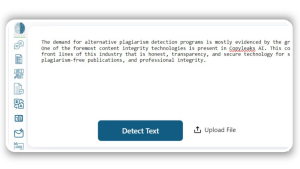
ZeroGPT makes use of a simple process to explore AI-generated texts:
The User pastes some text that he/she wants to be examined into the given place.
The tool spots the particular features in the text that are typical for AI-generated content.
ZeroGPT hands over a percentage of the AI probability measuring the potential to be AI-generated in the text.
In terms of my experience, ZeroGPT is particularly good for checking shorter texts and a quick scan. Its simplicity to use makes it a powerful tool for teachers who need to quickly assess students’ submissions.
Advantages of ZeroGPT
Easy to use: The tool interface is such that anyone, even without technical knowledge, can use it.
Fast: The results are almost immediately provided.
Accessibility: Being free and unregistered, it’s basically available for all the people.
Suitable for education: Its simplicity allows for its use in a school setting as well.
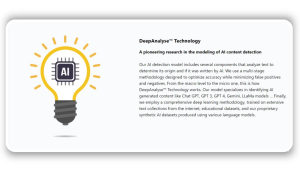
Limitations of ZeroGPT
Reduced analysis: The tool might not offer context-rich insights on why it marked a text as AI-generated.
Chance of false positives: As in any AI detection tool, ZeroGPT can sometimes misclassify human-written text as AI.
No other features: ZeroGPT is engaged solely on AI detection, unlike other products.
Copyleaks.AI: A Comprehensive Solution
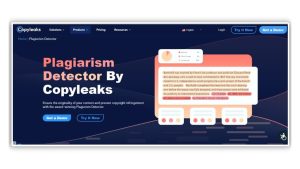
Copyleaks.AI, when compared to ZeroGPT, provides a wider set of tools. As an expert writer, I have found Copyleaks.AI to be a very satisfactory tool that goes through the materials deeply and also lets you use the interface with additional features.
Key Features of Copyleaks.AI
AI detection algorithms:
These algorithms provide higher accuracy, especially on long texts giving results compared to ZeroGPT.
Plagiarism checking:
It is a feature that sets it apart from other defense mechanisms.
Integration with multiple platforms:
Copyleaks.AI can be included with a learning management system and other platforms.
Comprehensive reports:
Users can see the results of their recovery scans displayed in depth.
Several languages:
For the discovery of artificial intelligence, application of logic and languages other than English are also possible.
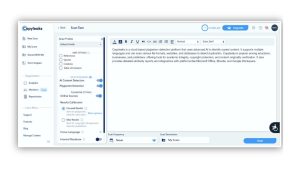
How Copyleaks.AI Works
Copyleaks.AI functions based on a more advanced method which involves the deep examination of contents:
The Platform users are required to submit texts by either typing them into the platform tool or by using the API that links directly to the user’s system.
Thanks to sound algorithms the tool can determine the occurrence of certain synaptic mechanisms thereby higher likeness to an AI-generated text.
At the same time, a check for possible plagiarism between the text and a large archive of documents is launched.
Copyleaks.AI retrieves detail information such as AI probability score and discussions of the plagiarized parts.
From my own point of view, Copyleaks.AI really helped me a lot in dealing with complicated writing tasks mostly these of longer form. Owing to its capability of giving detailed insights it can be applied by content producers for writing and also for professional development.
Advantages of Copyleaks.AI
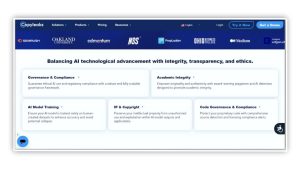
Elaborate analysis:
The platform provides complex and exhaustive AI detection and plagiarism reports.
Adaptability:
It is a versatile tool that can be leveraged by different industries and types of content.
Integration options:
Thus, it makes the integration with a company that needs AI detection easier.
Multi-language support:
As such tools are indispensable in a globalized world, this one feature is really appreciable.
Limitations of Copyleaks.AI
Cost:
Dissimilar to ZeroGPT, Copyleaks.AI is a paid utility that is not included in the basic plan, and accordingly, can be a deposit that prevents usage for many users.
Complexity:
The extra features provide you with comprehensive technical information but they may be disregarded by those who intend only to have quick simple results.
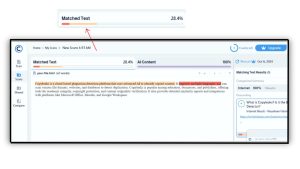
Learning curve:
People may have difficulty utilizing all the functions fully without the learning curve.
Comparison Table: ZeroGPT vs Copyleaks.AI
| FEATURE | ZERO GPT | COPYLEAKS.AI |
| COST | FREE | PAID |
| REGISTRATION REQUIRED | NO | YES |
| SPEED OF RESULTS | INSTANT | QUICK BUT MAY NOT BE VERY DETAILED |
| PLAGIARISM | NO | YES |
| DETAILED REPORTS | NO | YES |
| INTEGRATION CAPABILITIES | NO | YES |
| MULTILINGUAL SUPPORT | LIMITED | EXTENSIVE |
| USER INTERFACE POSSESSES | NO ADVANCE FEATURES | MORE, YET COMPLICATED INTERFACE |
| API ACCESS | NO | YES |
Use Cases and Applications
From my personal experiences, both ZeroGPT and Copyleaks.AI have applications that are unique to them and are useful in different cases.
ZeroGPT Use Cases
The assignment of tests in the classroom: Teachers cannot only tell the AI bypassers but the way in which this issue is dealt with is extremely cutting edge.
Short length communication: The instrument is suitable to make short messages and short articles clear enough. The glossary should not be confusing.
Self-calibrated communication: A person with a keen interest in disclosing whether or not a body of prose is computer-generated gets instant results.
Primary screening: ZeroGPT can act as a preliminary filter for multiple checkpoints work environments might be structured with.
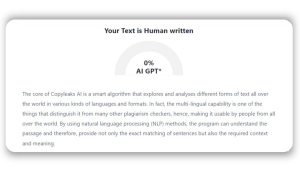
Copyleaks.AI Use Cases
Educational honesty: To make sure the authenticity of the work submitted by students most school institutions are using this software.
Professional publishing: This is a tool that authors and publishers use to evaluate the authenticity of their manuscripts.
Content Marketing: The ability of marketing agencies to cross-check their content for originality and not being written by machines is one of the key aspects of intellectual property protection.
Journalism: The issues of fake news and misinformation that were made available by the digital world eras are countered with the help of artificial intelligence-enabled software that verifies the authenticity of the submitted articles.
Legal documents: The tool encrypts almost all the words of the sentence in such to the idea of the originality of legal writings.
The Impact on Various Industries
The use of AI detection tools such as ZeroGPT and Copyleaks.AI will affect the operation process of many industries:
Education
These tools allow teachers and students to find new ways of dealing with assignments and assessments. They not only enable teachers to maintain the academic integrity by ensuring that students do not use AI to help themselves in writing homework but also have cought into controversy how digital and AI-assisted teaching methods scale learning in advanced technology.
Publishing
Owning to these screening instruments publishers are now empowered to alternatively and independently check the originality of the submissions. This is particularly relevant as AI increasingly gains ground in books and even tutorial works. At the same time, questions come into play about the future of authorship and the impact of human ingenuity on society.
Marketing
Within the marketing sector, these have proven to be a reliable source of information to affirm the credibility of the information. It’s a sign of the loyalty they have for their brands that they can show that they did it genuinely. However, it also appears that they would have a challenge of merging with the use of AI to be more productive, on the one hand and, on the other hand, not to lose the interaction with their customers.
Journalism
For news organizations, AI tools are a means through which the reporting process is made more credible. They can now verify that the submission of unsourced articles wasn’t typed by someone inanimate. This is more serious in a time like this one where fake news and disinformation floating around.

Ethical Considerations
The influence of AI detection apps raises several ethical questions:
Privacy:
Does the AI writer-detection method give clues about the identity of the writer?
Accuracy:
What are the possible consequences of false positives and false negatives?
Discrimination:
Are the tools as effective in detecting artificial intelligence-generated content in different languages and types of writings?
Imagination Affect:
Could the false accusation of content stem from AI-induced affectivity?
We have to focus on these ethical issues as we continue to apply and develop these tools.
Conclusion
Both ZeroGPT and Copyleaks.AI seem to be indispensable factors in the on-going development of content creation and authentication. ZeroGPT is very easy to deploy and provides rapid checks, making it a good choice in a classroom environment. It is a very convenient access and stable service for both the learners and teachers due to its user-friendly design and immediate results.
On the contrary, Copyleaks.AI is a more complete tool that is necessary for professional authors and content creators. Its feature-rich style, including plagiarism detection and detailed reports, provides a reliable mechanism to ensure content authenticity and originality.
The selection of the right tool for either of them will depend on the situation and the user’s needs. ZeroGPT is a good choice for quick and simple checks. However, for more extensive checks with plagiarism detection and other valuable properties, the better solution is Copyleaks.AI.
With the continuous development of AI, the significance of this type of detection will become even more important. These instruments are indispensable for the originality of human creativity and the value of content in many fields. Nevertheless, it’s crucial to use these technologies wisely and further elaborate on their human rights issues.
In my view, both ZeroGPT and Copyleaks.AI have demonstrated a true potential in the fight against AI-generated contents. We will need these tools, for sure, as we move the way towards the future and most likely they will lead the way for the rest of the tools coming while dealing with the presented challenges of human-generated content vs AI-generated one in future.
Frequently Asked Questions (FAQs): Copyleaks vs. ZeroGPT
| What are Copyleaks and ZeroGPT?
Copyleaks and ZeroGPT are both tools designed to detect AI-generated content. Copyleaks is a comprehensive plagiarism check platform that has expanded to also include AI content detection, while ZeroGPT is concentrated on the detection of the AI-generated text, ChatGPT model in particular. |
| How do Copyleaks and ZeroGPT differ in their approach to AI detection?
As I understand Copyleaks uses a multiple scrutiny structure where it mixes the AI content analysis with the conventional plagiarism detection. In contrast, ZeroGPT is the tool whose main goal is the identification of the text made by GPT models only. Both of these use different forms of complex programming, but their ranges and methods can differ. |
| Which tool is more accurate in detecting AI-generated content?
The improvement of the accuracy of either the tools is conditional to the material that is put through them. In various occasions, Copyleaks impressed me with its inclusive nature due to which the tool is able to detect wider array of AI-generated texts, whereas ZeroGPT is specialized mainly on GPT-generated text. However, the developers always bear in mind that it is impossible for all the AIs to be 100% clinical in their detection. |
| Are these tools free to use?
Copyleaks has both free and paid plans, but for the free version, the features are limited. As of my last update, ZeroGPT presented a free web-based tool for AI detection. Still, it is proper to visit their web resources to check their updated rates. |
| Can these tools detect content from all AI writing assistants?
Such tools are meant to help in the identification of AI-generated content, although this aspect may vary among the different AI writing assistants. Copyleaks is designed to detect the content from different AI clouds while ZeroGPT is concentrating on GPT-generated texts. |
| How user-friendly are Copyleaks and ZeroGPT?
My observation is that both of the tools represented embrace a user-friendly approach. Copyleaks features a dashboard packed with many different tools, making it hard to get the hang of it at the beginning. On the other hand, ZeroGPT usually uses a simpler interface where the user pays only attention to AI detection. |
| Can these tools be integrated into other platforms or workflows?
Copyleaks allows API integration thus it can be integrated into various platforms and workflows. ZeroGPT’s integration capabilities may be limited, but I suggest you to check their latest features for the most current data. |
| How do Copyleaks and ZeroGPT handle privacy and data security?
Both tools put their users’ privacy and data security on the top. Nevertheless, I would recommend you to take a quick look at the privacy clause of each tool. Copyleaks, being a more traditional platform, perhaps, has more reliable and comprehensive data protection elements. |
| Which tool is better for educational institutions?
As far as my understanding is concerned, Copyleak would be a more relevant tool for educational institutions due to the fact that it covers plagiarism detection in a detailed way and also does AI detection. Still, the selection of the tool also rests on the exact requirements and orientation of the educational institution. |
| Can these tools detect AI-generated content in languages other than English?
Copyleaks supports a large number of languages in both plagiarism detection and AI detection. ZeroGPT may be specific to detect content in English for now, it is focused mainly on English language. The most accurate information can be found on their current website. |
